Promising Areas for Marine Cloud Brightening
Marine Cloud Brightening (MCB) is most effective in regions with abundant low-level stratocumulus clouds, which cover large parts of the world’s oceans. These areas are essential targets for MCB due to their potential to significantly increase cloud reflectivity and reduce global temperatures.
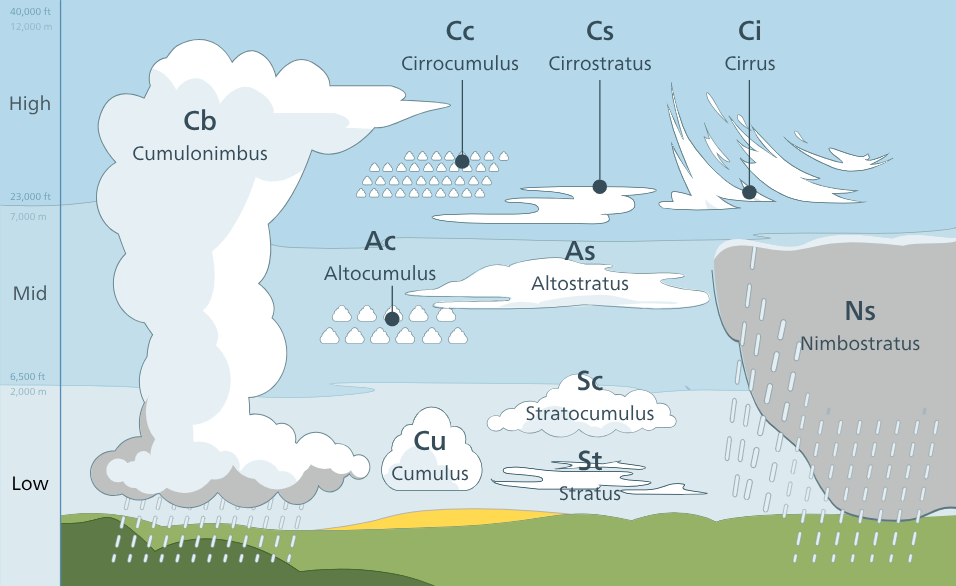
Tropospheric cloud classification by altitude of occurrence. Multi-level and vertical genus-types not limited to a single altitude level include nimbostratus, cumulonimbus, and some of the larger cumulus species.
Key Regions with Suitable Stratocumulus Cloud Cover
- Eastern Pacific Ocean:
- California Coast: The cool waters off the coast of California are home to extensive stratocumulus cloud cover, making it an ideal location for MCB.
- Peru and Chile: The Humboldt Current along the western coast of South America supports persistent stratocumulus clouds.
- Atlantic Ocean:
- Canary Current Region: Off the northwest coast of Africa, the Canary Current supports a large area of low-level stratocumulus clouds.
- Benguela Current: Off the southwest coast of Africa, the Benguela Current region also has significant stratocumulus cloud cover.
- Indian Ocean:
- Southwestern Indian Ocean: The area west of Australia and south of Indonesia has favorable conditions for MCB due to the presence of stratocumulus clouds.
- Southeastern Pacific Ocean:
- Off the Coast of South America: This region is known for its extensive stratocumulus cloud cover, driven by the cold upwelling waters of the Peruvian Current.
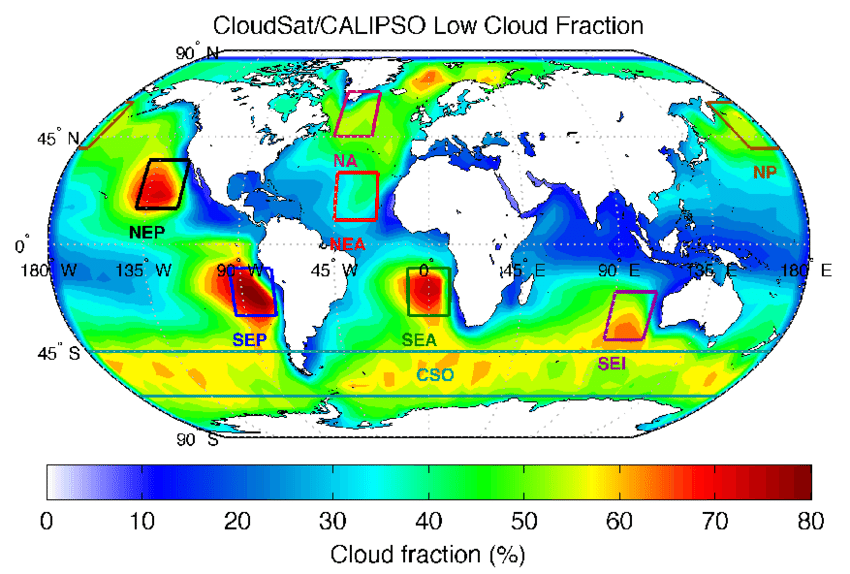
Promising areas with suitable low-level stratocumulus clouds.
(Atmos. Chem. Phys. Discuss., 2014: Climatology of stratocumulus cloud
morphologies: microphysical properties and radiative effects; Muhlbauer, et. al.)
Importance of Targeting These Areas
- High Cloud Albedo: Stratocumulus clouds have a high albedo (reflectivity), meaning they can reflect a significant amount of incoming solar radiation back into space.
- Extensive Coverage: These clouds cover vast areas of the ocean, providing a large-scale potential for cooling.
- Proximity to Major Emission Sources: Many of these regions are downwind of major industrial and urban areas, where cooling could mitigate the localized effects of climate change.
Implementation Considerations
- Delivery Systems: Various delivery methods, such as drones, windmill-mounted sprayers, or ships, can be used to disperse seawater aerosols into the atmosphere.
- Monitoring and Evaluation: Continuous monitoring using satellites, aircraft, and ground-based sensors is crucial to assess the effectiveness and impact of MCB.
- Environmental Impact: Detailed environmental impact assessments must be conducted to ensure the safety and sustainability of MCB interventions.
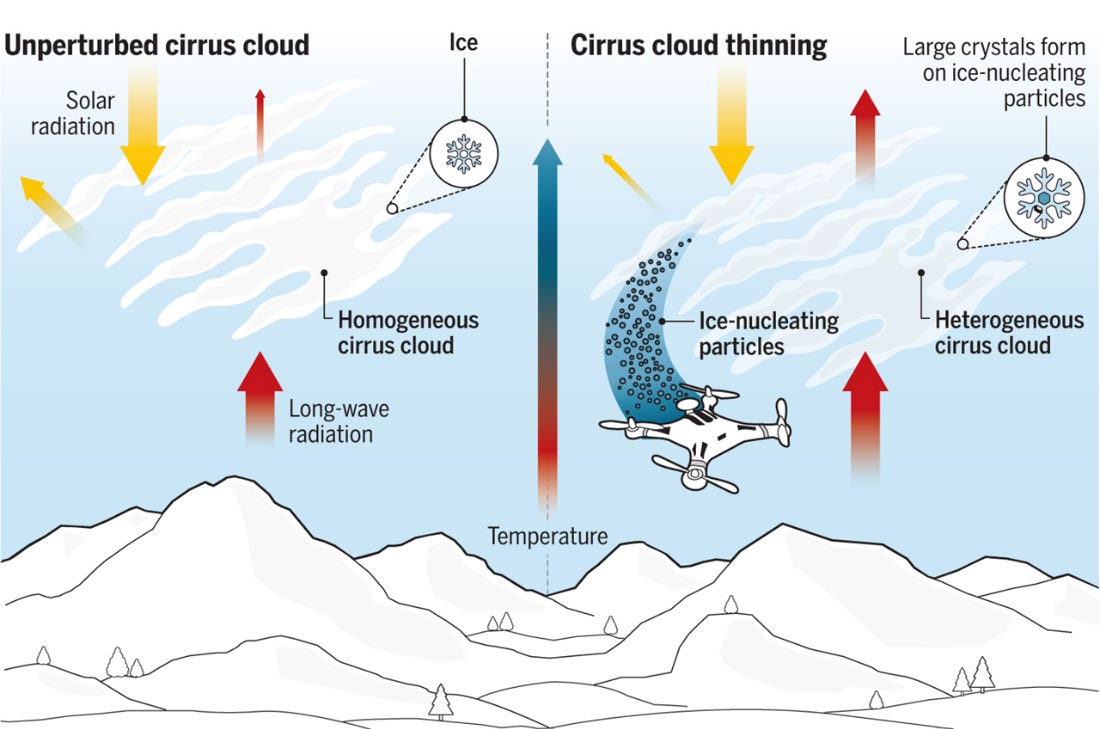
Conclusions
Targeting regions with abundant low-level stratocumulus cloud cover is essential for the success of Marine Cloud Brightening. These areas, which include parts of the Eastern Pacific, Atlantic, and Indian Oceans, offer the best conditions for maximizing the cooling effects of MCB. By focusing efforts on these promising regions, we can enhance the reflectivity of clouds and help mitigate global warming while continuing to pursue long-term solutions to reduce greenhouse gas emissions.
Field Testing for Marine Cloud Brightening
Field testing is a critical step in the development and deployment of Marine Cloud Brightening (MCB) technology. These tests aim to validate the effectiveness, safety, and scalability of MCB in real-world conditions, ensuring that it can provide the desired cooling effects without causing unintended consequences.
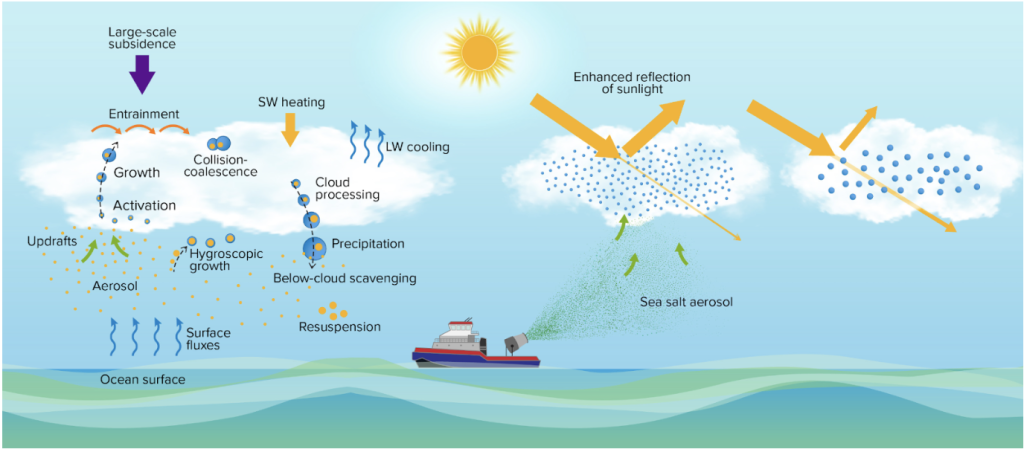
Objectives of Field Testing
- Effectiveness: To determine how well MCB increases cloud reflectivity and achieves cooling.
- Safety: To assess any potential environmental or ecological impacts.
- Scalability: To evaluate the practicality of deploying MCB on a larger scale.
- Operational Feasibility: To test the logistics of different delivery systems, such as drones or windmill-mounted sprayers.
Key Components of MCB Field Testing
- Site Selection: Identifying appropriate oceanic regions with abundant stratocumulus clouds, typically areas with consistent cloud cover and minimal human interference.
- Delivery Systems: Testing various delivery methods, including drones, windmill-mounted sprayers, and other innovative technologies, to disperse seawater aerosols into the atmosphere.
- Monitoring and Measurement: Using satellites, aircraft, and ground-based sensors to monitor changes in cloud properties, reflectivity, and local climate conditions.
- Environmental Impact Assessment: Conducting comprehensive studies to evaluate the potential impacts on marine and atmospheric ecosystems.

Steps in the Field-Testing Process
- Preparation Phase:
- Research and Development: Enhancing the design of delivery systems to maximize efficiency and effectiveness.
- Regulatory Approval: Securing necessary permits and approvals from relevant authorities.
- Pilot Tests:
- Initial Trials: Conducting small-scale tests to refine techniques and gather preliminary data.
- Data Analysis: Assessing the results to inform subsequent larger-scale tests.
- Scaling Up:
- Expanded Trials: Implementing larger-scale tests based on successful pilot test results.
- Continuous Monitoring: Using advanced monitoring techniques to track cloud changes and environmental impacts over extended periods.
- Evaluation and Adjustment:
- Impact Assessment: Continuously evaluating environmental and climatic impacts to ensure safety and effectiveness.
- Technological Refinement: Making necessary adjustments to the delivery systems and methodologies based on test outcomes.
Potential Challenges and Considerations
- Environmental Risks: Ensuring that the introduction of salt aerosols does not disrupt marine ecosystems or weather patterns.
- Regulatory and Ethical Issues: Addressing concerns about geoengineering and gaining public and governmental support.
- Technological Limitations: Overcoming technical hurdles related to the dispersion of aerosols and the sustainability of delivery systems.
Case Studies and Precedents
Field testing of MCB has been informed by previous research efforts:
- University of Edinburgh: Initial research by Professor Stephen Salter.
- Cambridge, Delft, USA, and Australia: Subsequent studies contributing valuable data and insights.
- SO₂ Emissions from Ships: Historical observations of the cooling effects of sulfur dioxide emissions provide a real-world precedent for MCB.
In the concept developed by Stephen Salter, the Nestor of research in MCB, ships are pushed forward by Flettner rotors.
In this futuristic design, the spray heads are placed in a vertical line on a mizzenmast which can rotate to point downwind. The power for spraying will come from four variable pitch hydrofoils on hinged arms.
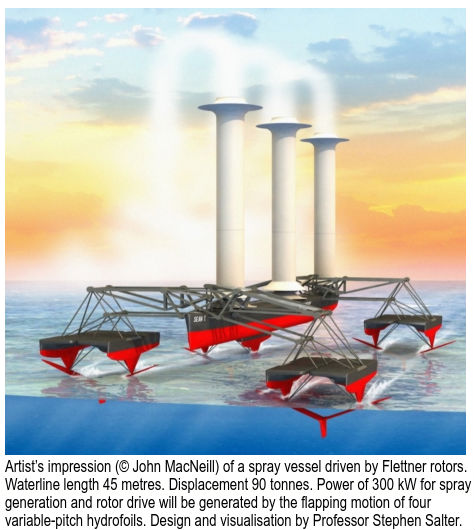
Artist impression of Stephen Salters sea-going Marine Cloud Brightening vessels (Salter et al., 2008). Salters approach (e.g., cloud physics) can be tested at relatively small scale.
Conclusion
Field testing is an essential phase in the development of Marine Cloud Brightening, aimed at validating its potential as a temporary climate intervention tool. By rigorously testing and refining MCB technologies, we can ensure they are safe, effective, and scalable. These efforts will help provide a critical bridge to longer-term climate solutions, buying time to address the root causes of global warming while minimizing immediate temperature increases.
Promising Trials to Save the Great Barrier Reef
Some interesting trials have been performed to save the corals of the Great Barrier Reef along the coast of northwestern Australia. These trials represent the first real open-air test with a spraying device to produce aerosols for Marine Cloud Brightening (MCB). The results have been promising, marking a significant step forward in climate intervention technologies.
The Great Barrier Reef Trials
- Objective: The primary goal of these trials was to assess the feasibility of using MCB to protect coral reefs by reducing water temperatures and mitigating the effects of coral bleaching.
- Method: Spraying devices were used to disperse fine seawater droplets into the atmosphere. These droplets evaporate, leaving behind tiny salt particles that rise and encourage the formation of brighter, more reflective clouds.
Key Findings
- Aerosol Dispersal: One of the critical outcomes of the trials was that the aerosols produced by the spraying devices did, in fact, rise into the air as predicted by models. This confirms that the basic mechanism of aerosol dispersal works in real-world conditions.
- Cloud Formation: The trials provided valuable data on how these aerosols contribute to cloud formation and the potential increase in cloud albedo (reflectivity).
Implications and Next Steps
- Not Yet Proof of Concept: While these trials are a good first step, they do not yet constitute proof of concept. Further research and more extensive testing are needed to fully understand the efficacy and potential side effects of MCB.
- Scaling Up: Future trials will need to scale up the operation to larger areas and over longer periods to evaluate the sustainability and impact of MCB on marine ecosystems and climate.
Conclusion
The initial trials of MCB along the coast of northwestern Australia to protect the Great Barrier Reef have yielded encouraging results. The successful dispersal of aerosols into the atmosphere as modeled marks an important milestone. While this is not yet proof of concept, it represents a significant first step towards developing viable climate intervention strategies to protect vulnerable ecosystems like coral reefs. Further research and testing will be crucial to refine these techniques and ensure their effectiveness and safety in mitigating the impacts of climate change.
Act on the Acceleration of Global Climate Cooling Solutions
The Blue Cooling Initiative is an urgent and critical response to the accelerating climate crisis, spearheaded by a diverse coalition of scientists, opinion leaders, civil servants, and politicians through:
- Funding and Support: Securing resources from governments, private sector, and international organizations to accelerate R&D.
- Collaboration: Fostering partnerships among scientists, policymakers, and industry leaders to address technical and regulatory challenges.
- Education and Engagement: Raising awareness and building support among the public and stakeholders through outreach and education efforts.